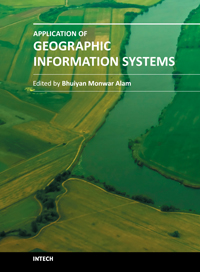
|
FreeComputerBooks.com
Links to Free Computer, Mathematics, Technical Books all over the World
|
|
- Title: Application of Geographic Information Systems
- Author(s) Bhuiyan Monwar Alam
- Publisher: IN-TECH; eBook (Creative Commons Licensed)
- License(s): CC BY 3.0
- Hardcover: 372 pages
- eBook: PDF files, and a Zipped PDF, 39.58 MB
- Language: English
- ISBN-10: N/A
- ISBN-13: 978-953-51-0824-5
- Share This:

|
The book blends together the theories of GIS and their practical implementations in different conditions. It deals with GIS's application in the broad spectrum of geospatial analysis and modeling, water resources analysis, land use analysis, infrastructure network analysis like transportation and water distribution network, and such.
The book is expected to be a useful source of knowledge to the users of GIS who envision its applications in their teaching and research. This easy-to-understand book is surely not the end in itself but a little contribution to toward our understanding of the rich and wonderful subject of GIS.
About the Authors- Bhuiyan Monwar Alam (Ph.D., Florida State University) is an Associate Professor of Urban and Regional Planning in the Department of Geography and Planning at the University of Toledo, Ohio, USA.
- Geographic Information System (GIS), Web Mapping, and GPS
- Data Analysis and Data Mining, Big Data
- Statistics and SAS Programming

- Application of Geographic Information Systems (Bhuiyan Monwar Alam)
- PDF Format
- Geographic Information Systems And Science (Paul A. Longley)
-
 GIS and Housing: Principles and Practices
GIS and Housing: Principles and Practices
This book provides GIS technicians and analysts with an overview of US housing challenges and examples of how to effectively integrate spatial thinking to address housing policy questions.
-
 Shifts in Mapping: Maps as a Tool of Knowledge (C. Schranz)
Shifts in Mapping: Maps as a Tool of Knowledge (C. Schranz)
Depicting the world, territory, and geopolitical realities involves a high degree of interpretation and imagination. Cartography originated in ancient times to represent the world and to enable circulation, communication, and economic exchange.
-
 Introduction to Python for Geographic Data Analysis
Introduction to Python for Geographic Data Analysis
Introduce the basics of Python programming and geographic data analysis for all “geo-minded” people (geographers, geologists and others using spatial data). Apply Python GIS geospatial processes to a variety of problems, and work with remote sensing data.
-
 Nature of Geographic Information Systems (David DiBiase)
Nature of Geographic Information Systems (David DiBiase)
The purpose of this book is to promote understanding of the Geographic Information Science and Technology enterprise (GIS&T, also known as 'geospatial'). It explores the nature of geographic information.
-
 An Introductory Textbook on Geographic Information Systems
An Introductory Textbook on Geographic Information Systems
This textbook is an introduction to GIS, but most of the chapter's concepts are also applicable to other geotechnologies including remote sensing, global positioning systems (GPS), Internet mapping, and virtual globes.
-
 Geographic Information System Basics (Jonathan Campbell)
Geographic Information System Basics (Jonathan Campbell)
From the melting of the polar ice caps to privacy issues associated with mapping, this book provides a gentle, yet substantive, introduction to the use and application of digital maps, mapping, and GIS.
-
 Principles of Geographic Information Systems (GIS)
Principles of Geographic Information Systems (GIS)
This book is designed to provide students in a first or second GIS course with a solid foundation in both GIS concepts and the use of GIS. It strikes a careful balance between GIS concepts and hands-on applications.
-
 GIS Succinctly (Peter Shaw)
GIS Succinctly (Peter Shaw)
This book guides you through it all, starting with a detailed examination of the data and processes that constitute the internals of a GIS. It surveys a selection of commercial and open-source software packages, detailing the strengths and weaknesses of each.
-
 Geospatial Analysis: Principles, Techniques and Software Tools
Geospatial Analysis: Principles, Techniques and Software Tools
This book provides a compehensive guide to concepts, methods and tools, with many examples being provided using a variety of software tools such as ArcGIS, Idrisi, Grass, Surfer and many others to clarify the concepts discussed
-
 Geospatial Analysis with Python (Ujaval Gandhi)
Geospatial Analysis with Python (Ujaval Gandhi)
Suitable for GIS practitioners with no programming background or python knowledge. The course will introduce basic Python programming concepts, libraries for spatial analysis, geospatial APIs and techniques for building spatial data processing pipelines.
-
 Python Scripting for Spatial Data Processing (Pete Bunting, et al)
Python Scripting for Spatial Data Processing (Pete Bunting, et al)
This book is a Python tutorial for beginners aiming at teaching spatial data processing. It is used as part of the courses taught in Remote Sensing and GIS, using psycopg2, and ogr2ogr, etc., at Aberystwyth University, UK.
-
 Spatial Thinking in Planning Practice: An Introduction to GIS
Spatial Thinking in Planning Practice: An Introduction to GIS
The goals of this textbook are to help students acquire the technical skills of using software and managing a database, and develop research skills of collecting data, analyzing information and presenting results.






